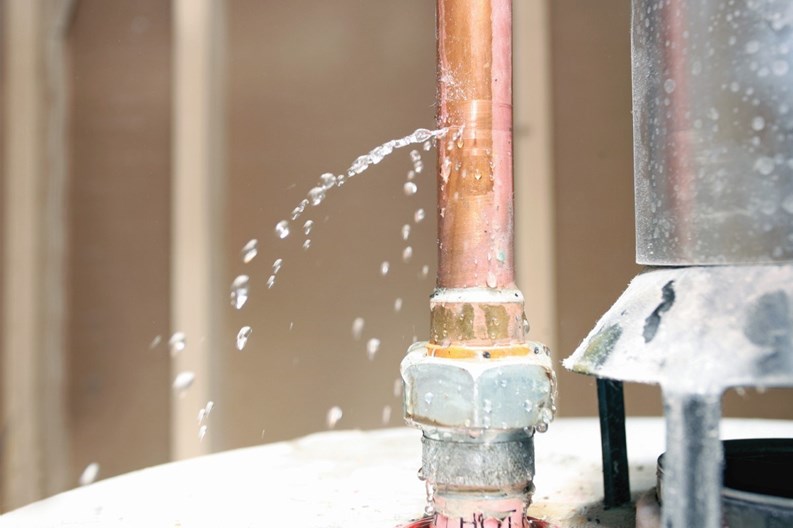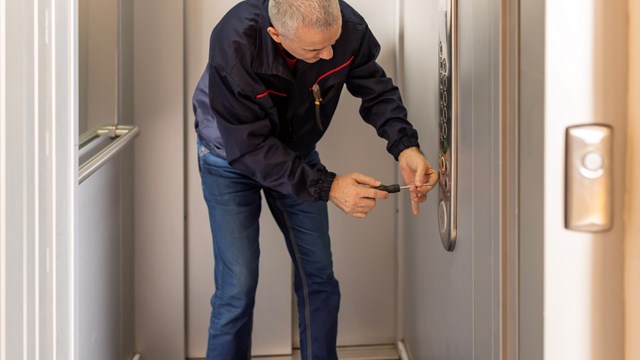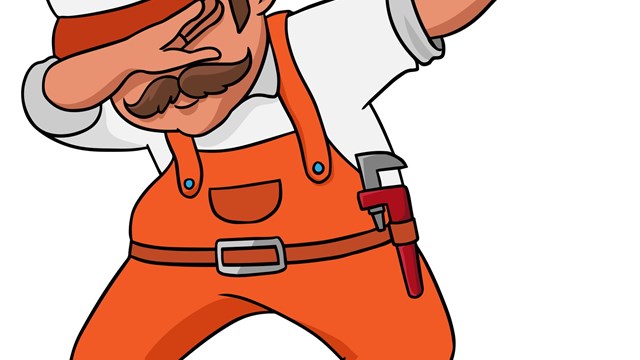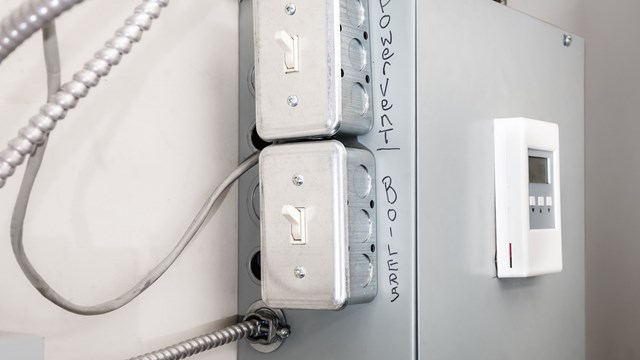Though mostly unseen, a building’s plumbing and piping network is one of its most important systems—as anyone who has ever had to endure a no-hot-water shower in February, or who has come home to a flooded floor can attest. Plumbing covers not only hot water delivery, but water and waste removal—and not all plumbing is hidden. Some pipes snake across ceilings, or down walls inside individual units, making the plumbing more visible than the HVAC or electrical wiring in most buildings.
Plumbing is something many of us take for granted—until a faucet leaks, a sewer pipe bursts, a hot water heater dies, or some other disaster occurs. Let’s take a closer look at this essential building component.
H2O HISTORY
If you’ve ever been on a tour of Rome, you know that plumbing, in some form or other, has been around for millennia. In ancient Greece, Persia, India, and China, as well as Rome, public bath houses mandated a rudimentary form of plumbing. When Rome fell, its knowledge of plumbing fell, too, and it wasn’t until the 1800s that mankind reacquired the technology to pump water in and out of residences.
The word plumber comes from the Latin root plumbum, meaning lead, which is why the chemical symbol for lead is Pb. From its earliest days until the last century, plumbing systems were made almost exclusively of lead. The relative malleability of the soft metal made it easy to work with. Lead, of course, can be poisonous—the use of lead pots and pans in ancient Rome indirectly led to its fall—and in the last half-century, plumbers have used other materials instead of lead.
“As recently as the 1970s, all waste piping was extra-heavy cast iron, joined together by lead,” says Michael Battista, president of R&R Battista in Watertown, Massachusetts. “Vent piping was with cast iron or galvanized steel that was threaded and screwed together. Water piping was copper tubing soldered together.”
Back then, the copper tubing was Type M, the thinnest copper pipe available.
“The solder was lead-based,” Battista says. “Then they found out that lead was leeching into the water supply.”
This discovery led to a series of prohibitions, and changes in the materials plumbers used. The old solder was replaced with a lead-free variety, and Type M pipe was changed to the wider Type L, which cut down on blockages.
Economics drove some important changes as well. The prohibitive cost of iron and steel gave way for copper to be more widely used. In the late 1970s, plastic began to be used in residential buildings (it remains illegal to do so on commercial properties).
Perhaps most significantly, the way that pipes were joined together changed radically.
“Instead of being joined with lead, it was joined with clamps,” says Battista. “It was less expensive to produce, and labor-wise, easier than welding.”
Clamps, press fits, and grooves are all widely used today. In the case of natural gas piping, a single coil of pipe is used, so joining isn’t even necessary.
“There’s a big move away from open-flame methods,” which obviously a pose fire risk, says Battista.
PLUMBING TODAY
In multifamily buildings, traditionally, the plumbing system is shared. The boiler room is the generating station for the entire building. Water is shared, and the water bill is split evenly among the residents as part of the maintenance charges.
Buildings are moving away from that system, Battista says.
“Water has become so expensive, it’s important to charge the owner directly, instead of whacking it up evenly, like it used to be,” he explains. “It was included with the rent in the old days.”
The recent trend is for buildings to assume the condominium model as much as possible—that is, for each unit to have its own water system.
“With a condo, control of the water is usually done within the unit,” says Battista. “It’s in a mechanical room within a unit, that the owner can open—the hot water heater.”
Another trend is the use of new materials, made out of different types of plastic such as polyvinyl chloride or PVC. This can pose problems in condominiums.
“A lot of installers don’t know how to install the new piping,” says Battista. “If you don’t do it right, you get leaks in the plastic tubing.”
TROUBLESHOOTING
With all the talk of pipes and piping systems, the problems plumbers face most often have to do with fixtures, tubs, toilets, and appliances. “We see a lot of clogged toilets,” says Yavi Golani, owner of YG Services in Watertown, Massachusetts. “Or there’s no heat in the hot water heater. Broken toilets, garbage disposals.”
Dave Fox, the owner of ASA Plumbing & Heating Services in Enfield, Connecticut, sees similar small-scale problems. “Shower valves, drains for the tub and shower—all bath stuff, really,” he says.
In multifamily buildings, these sorts of leaks can have a trickle-down effect—literally. A leaking tub drain on the third floor can ruin the ceiling of the unit below. “We’re forever opening ceilings,” says Battista.
Then there are times when the problem is not confined to one unit.
“I had the sewer main break in a 30-unit apartment,” Fox recalls. “The sewer main under the building snapped, sewage was coming up—and people were still living there.”
It took two days to clean up the mess and fix the leak.
Sometimes people flush the darnedest things down the toilet. What’s the strangest thing you ever found in a pipe?
“Somebody tried to flush a small baseball,” says Golani. “And condoms are everywhere.”
“I found a squirrel,” says Fox. (The animal did not survive the adventure).
HELPFUL TIPS
Plumbing is mostly beyond the scope of your average resident. Other than knowing how to turn valves on and off in case of emergencies—if you don’t know where your valves are, find them, and make sure that they work properly—there’s not much residents can do to ease the strain on the plumbing.
“You can’t do anything to the pipes” to service them, Golani says.
Still, there are some things owners can do to forestall larger disasters. The first, and most obvious, is: don’t flush anything down the toilet other than toilet paper and waste.
While the pipes don’t need to be cleaned, the boiler and furnace are a different story.
“Do maintenance to the boiler once a year,” Golani advises.
The New England winter requires some measures to protect the pipes.
“In the winter, always keep your heat up, of course, so it doesn’t freeze up,” says Fox.
Fox also advises snaking the sink and tub drains twice a year. This helps the flow of the system and saves the cost of the plumber.
“Most of the time, the blockages are hair,” he says.
Battista has advice that is specific for Massachusetts.
“A big problem is the use of non-state-approved plumbing fixtures,” he says. “You can buy them in the store, but that doesn’t mean they are Mass.-approved. And if it’s not approved by the plumbing board, it can’t be used in Massachusetts.”
He has seen cases where owners spend$5,500 for a bathtub, have a plumber install it, and have an inspector make them tear it out because it isn’t an approved tub. This is, of course, a huge waste of money.
Water heaters are something else to be aware of. They are generally covered under warranties for 'x' number of years, but that doesn’t mean they are built to last.
“You get runs on water heaters,” Battista says. “We get big water heater failure rates. Most water heaters fail before their warranties expire.”
It’s a good idea, then, to register that new purchase, and make sure to keep the paperwork, in case it’s a lemon.
Finally, a multifamily building is a complex apparatus. With shared water heaters, there needs to be enough hot water to handle the morning shower rush, but there also needs to be enough for the mom who has to run a bottle under the hot water faucet at 3 o'clock in the morning. This is achieved by a system of mixing valves.
“Those valves need service every month,” Battista says. “They calcify, and they don’t work right. So they turn up the hot water heater, but it’s the mixing valves that are the problem.”
Follow the advice of these plumbers, and you will improve your odds of never having a big fix.
Greg Olear is a freelance writer for New England Condominium magazine and other publications.







4 Comments
Leave a Comment